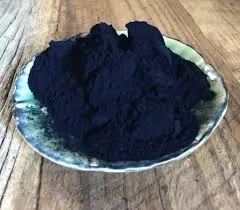The Rich History and Cultural Significance of Indigo Dye in Denim Production
The Cultural Significance of Denim Dye Indigo
Denim, a sturdy cotton fabric, has deep roots in fashion history, but it is the dye that gives it its unique character and appeal that deserves special attention—indigo. The deep blue hue of denim, derived from indigo dye, has not only defined the look of countless fashion trends but has also shaped various cultures around the world. Understanding the significance of indigo dye in denim production and its cultural implications offers insights into both fashion and the historical context of textile production.
Historical Background of Indigo Dye
Indigo dyeing has ancient origins, tracing back thousands of years. It was first cultivated in regions such as India, Egypt, and China, where civilizations recognized the value of indigo as a colorant. The dye is extracted from the leaves of the indigo plant, specifically from species like Indigofera tinctoria. This dyeing technique is distinct due to its complex chemical process, wherein the leaves are fermented to produce a rich blue pigment.
In Europe, indigo entered the textile trade during the 16th century through colonial importation. Its arrival sparked an interest in blue textiles, perhaps due to its vibrant, long-lasting color. However, the cost of indigo dye made it a luxury item for a time, accessible primarily to the affluent, thus establishing a social hierarchy defined by color.
Indigo and Denim A Perfect Match
The relationship between indigo dye and denim fabric began in the late 19th century. Denim originated as a utilitarian fabric, favored by laborers for its durability. The shift towards indigo dyeing occurred as manufacturers sought to produce blue work garments that could withstand the rigors of hard labor while masking dirt effectively. This practical application of indigo dye not only provided a functional wardrobe for workers but also laid the groundwork for an iconic fashion statement.
The process of dyeing denim with indigo is unique as it involves multiple dips in dye baths, allowing the fabric to gradually absorb the deep blue shade while maintaining a distinctive chalky finish on the surface. This technique also contributes to the charm of denim—its ability to fade over time, creating a personalized garment as it ages. This fading process has further established the notion of 'authenticity' in denim fashion, making it a canvas for individual expression.
denim dye indigo

Cultural Implications of Indigo Dye
Beyond its application in fashion, indigo dye holds significant cultural importance in various societies. In Japan, for instance, the traditional art of indigo dyeing, known as 'aizome,' has been practiced for centuries. Japanese artisans have developed sophisticated techniques to create intricate patterns using an indigo dye that reflects their cultural heritage. Items dyed with indigo in Japan are not merely clothing but symbols of craftsmanship and tradition interconnected with history.
In West Africa, indigo dyeing is linked to cultural identity and community heritage. The dyeing process, often performed in communal settings, fosters collaboration and story sharing among artisans. Garments dyed with indigo often feature traditional motifs, acting as a medium for storytelling and preserving the history of generations.
The Modern-Day Revival of Indigo Dyeing
In recent years, there has been a resurgence of interest in natural dyes, including indigo, driven by a greater awareness of sustainability and ethical fashion. While synthetic dyeing methods are prevalent, many designers and consumers are increasingly turning to natural indigo as a way to reduce environmental impact. This revival not only highlights the importance of preserving artisanal techniques but also encourages a closer connection between consumers and the origins of their clothing.
The contemporary denim market is flooded with options, from artisanal brands emphasizing sustainable practices to mainstream labels recognizing the value of indigo's cultural significance. As denim continues evolving, the legacy of indigo dye remains a testament to the intertwined relationship of fashion, culture, and identity.
Conclusion
Indigo dye is much more than a pigment; it represents centuries of tradition, culture, and innovation. From its origins in ancient civilizations to its role in the denim industry today, the journey of indigo underscores the profound connection between human expression and textile production. As we embrace denim, we also embrace the rich narrative that indigo dye carries, weaving together the past, present, and future of fashion.
-
The Timeless Art of Denim Indigo Dye
NewsJul.01,2025
-
The Rise of Sulfur Dyed Denim
NewsJul.01,2025
-
The Rich Revival of the Best Indigo Dye
NewsJul.01,2025
-
The Enduring Strength of Sulphur Black
NewsJul.01,2025
-
The Ancient Art of Chinese Indigo Dye
NewsJul.01,2025
-
Industry Power of Indigo
NewsJul.01,2025
-
Black Sulfur is Leading the Next Wave
NewsJul.01,2025

Sulphur Black
1.Name: sulphur black; Sulfur Black; Sulphur Black 1;
2.Structure formula:
3.Molecule formula: C6H4N2O5
4.CAS No.: 1326-82-5
5.HS code: 32041911
6.Product specification:Appearance:black phosphorus flakes; black liquid

Bromo Indigo; Vat Bromo-Indigo; C.I.Vat Blue 5
1.Name: Bromo indigo; Vat bromo-indigo; C.I.Vat blue 5;
2.Structure formula:
3.Molecule formula: C16H6Br4N2O2
4.CAS No.: 2475-31-2
5.HS code: 3204151000 6.Major usage and instruction: Be mainly used to dye cotton fabrics.

Indigo Blue Vat Blue
1.Name: indigo blue,vat blue 1,
2.Structure formula:
3.Molecule formula: C16H10N2O2
4.. CAS No.: 482-89-3
5.Molecule weight: 262.62
6.HS code: 3204151000
7.Major usage and instruction: Be mainly used to dye cotton fabrics.

